
![]()
The Solar Weatherization Assistance Program (SWAP) was a joint effort of the U.S. Department of Energy (DOE), the Florida Department of Community Affairs (DCA) and the Florida Solar Energy Center (FSEC). The goal of the program was to provide solar water heating systems for low-income residents in Florida.
 Raising families, incurring everyday bills and purchasing common necessities are all part of daily life that can rapidly drain a family's budget. This is especially burdensome for low-income and elderly residents on a fixed or service economy income. A major part of the budgetary concerns are the unavoidable electric bills. This is a major concern for low-income residents since studies have shown that 11 percent of a low-income residents' yearly income goes toward paying energy bills (note that for mid-income residents, only 3 percent of the yearly income goes toward paying energy bills).
Raising families, incurring everyday bills and purchasing common necessities are all part of daily life that can rapidly drain a family's budget. This is especially burdensome for low-income and elderly residents on a fixed or service economy income. A major part of the budgetary concerns are the unavoidable electric bills. This is a major concern for low-income residents since studies have shown that 11 percent of a low-income residents' yearly income goes toward paying energy bills (note that for mid-income residents, only 3 percent of the yearly income goes toward paying energy bills).
In northern colder climates, weatherization programs assist low-income clients in reducing their energy costs by conducting weatherization on existing homes. Very often, may northern weatherization measures are not cost-effective in warmer climates. Therefore, it makes sense to take advantage of Florida's abundant and renewable solar energy resource to help reduce energy costs in low-income residences.
Program objectives
Participating agencies
Installed solar systems
Monitoring results
System owner surveys
Clients' stories
Ten Years After
The major objectives of the SWAP program included:
1. Reducing energy consumption and energy bills for low-income residents
2. Calculating the savings-to-investment ratio from the DOE weatherization audit procedure (NEAT)
3. Evaluating the feasibility of solar systems as a weatherization program option in warm climates
4. Providing a niche and seasonal market for the solar industry
5. Reducing Low Income Home Energy Assistance Program (LIHEAP) expenditures
DCA provided grants to local Weatherization Assistance Program agencies and other non-profit agencies to operate the program, while SWAP-certified solar contractors provided installations.
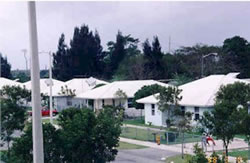 The program was administered in rural and urban communities by non-profit organizations and governmental agencies in cooperation with local volunteer groups.
The program was administered in rural and urban communities by non-profit organizations and governmental agencies in cooperation with local volunteer groups.
FSEC established an extensive database to compile and store information obtained by site inspections, surveys, utility bill analysis and computerized data acquisition at more than 30 sites, where such variables as water temperature, water consumption, and power consumption were monitored.
FSEC also developed all technical guidelines and provided on-going technical assistance, training, and program support to DCA and all participating local agencies and installers.
SWAP participating agencies in Florida

Several types of solar systems were installed under the SWAP program. The primary ones were the Integral Collector Storage (ICS) and the direct pumped systems.
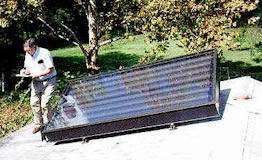 In the ICS unit (left), one can clearly see the large tubes in which water is heated and stored. ICS systems combine both the heat collection and storage in one unit. Water is heated in the ICS tubes and flows to the back-up water heater when the client uses hot water.
In the ICS unit (left), one can clearly see the large tubes in which water is heated and stored. ICS systems combine both the heat collection and storage in one unit. Water is heated in the ICS tubes and flows to the back-up water heater when the client uses hot water.
Of course, both ICS and pumped systems include a back-up electric water heater for use during inclement weather.
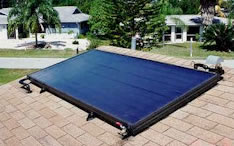 The flat-plate solar collector (right) is mounted on a residence in Miami. This collector uses a pump to help circulate water through the small tubes in the collector.
The flat-plate solar collector (right) is mounted on a residence in Miami. This collector uses a pump to help circulate water through the small tubes in the collector.
Direct pumped systems include a pump and some type of controller that determines when the pump should be on. The pump then forces water through the solar collector, where it is heated and returned to the water heater in the house.
| Florida Location | Agency | System | Total Installed Systems | Average System Cost |
| North | Central | ICS | 45 | $1,641 |
| Suwannee | ICS | 90 | $1,631 | |
| Suwannee | Pumped | 1 | $1,690 | |
| Tri-County | ICS | 48 | $1,641 | |
| Central | Citrus | ICS | 25 | $1,516 |
| Citrus | Pumped | 4 | $1,388 | |
| Citrus | Thermo | 1 | $1,690 | |
| Mid-Florida | ICS | 162 | $1,497 | |
| Mid-Florida | Pumped | 28 | $1,384 | |
| Pinellas | Pumped | 5 | $1,535 | |
| Pinellas | Thermo | 1 | $1,750 | |
| South | Metro-Dade | Pumped | 307 | $1,501 |
| Centro | ICS | 4 | $1,540 | |
| Centro | Pumped | 30 | $1,423 | |
| Lee County | ICS | 19 | $1,641 | |
| Lee County | Pumped | 31 | $1,414 | |
| Total Installed Systems | 801 | - |
||
| Average Cost | $1,555 |
 In order to access the viability of solar systems as well as low-income hot water use characteristics, FSEC conducted detailed instrumented monitoring at more than 30 swap sites.
In order to access the viability of solar systems as well as low-income hot water use characteristics, FSEC conducted detailed instrumented monitoring at more than 30 swap sites.
The following were monitored at the instrumented sites:
- Cold and hot water temperatures
- Collector feed and return line temperatures
- Flow to and energy usage of water heater
- Horizontal solar radiation
- One-time measurement of pump and controller power usage
- Scanned data every 15 seconds-stored average-totals every 15 minutes
- Ambient temperature during pre-solar monitoring
SWAP monitoring program results
| Parameter | Pre Solar | Post Solar |
| Average Family Size | 4.7 | 4.4 |
| Average water heating energy consumption (kWh per system, per year) | 3,100 | 1,500 |
| Water heating costs per year ($.08 per kWh) | $250 | $120 |
| NEAT Savings-to-Investment ratio ($.08 per kWh) | N/A | 1.0 |
| Solar Fraction (Percentage of hot water heated by solar) | N/A | 0.53 |
| Average system Coefficient of Performance | 0.73 | 1.4 |
| Average SWAP solar system installed cost | N/A | $1,550 |
| Gallons used - Family per day | 63.8 | 62.5 |
| Gallons used - Per person per day | 13.6 | 14.2 |
| Average hot water temperature (F) | 119 | 119 |
The following charts are based on instrumented monitoring data from 32 SWAP sites.
SWAP monitoring annual energy usage

Pre-solar energy usage and energy costs are greatly affected by factors such as water usage and existing water heater and water heater thermostat settings. Post-solar system usage and savings are affected by the above as well as timing of loads, solar radiation, and solar system performance.
SWAP monitored systems water heating ratio

This chart indicates the percentage of electrical energy devoted to heating water. The amount varies by site and is typically a very substantial portion of the utility bill. Solar systems reduce this percentage dramatically.
SWAP monitored systems water usage profile

This water usage pattern is very favorable for solar water heating since peak usage is in the evening.
System owner surveys and inspections
Surveys were sent to more than 800 clients that had received a solar system. More than 35 percent responded. Overall, the surveys indicated that:
- most participants were satisfied with their systems
- participants were aware of the weather-sensitive nature of the solar systems
- participants need more information and education regarding system operation, maintenance, etc.
FSEC staff inspected more than 200 of the installed systems, looking at the quality of the installations as well as system/component problems. In general, the inspections revealed:
- Few component failures
- Most installation discrepancies are easily fixed
- Most discrepancies are related to workmanship rather than equipment problems
- Post-installation inspections are critical.
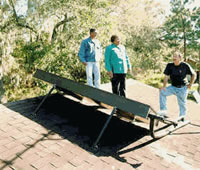 Brenda Mobley, SWAP Program Manager for the Mid Florida Community Services Agency, believes that ". . . a solar water system doesn't just help with the energy bill, it also relieves other financial stress."
Brenda Mobley, SWAP Program Manager for the Mid Florida Community Services Agency, believes that ". . . a solar water system doesn't just help with the energy bill, it also relieves other financial stress."
She adds that, "For a program that reduces your energy bill and doesn't cost you a penny, the solar heater is the way to go. This program has proven itself to many low-income clients in Hernando and Sumter Counties. Several clients have made a point of telling me personally that the solar water heaters have cut their electric bill in half and have advised anyone to take advantage of this worthwhile program. The SWAP program has been very worthwhile in meeting Mid Florida’s primary mission of reducing the energy costs of low-income clients."
Sims
Although it’s easy to get lost in the technicalities of this program, the end product is that these solar systems are affecting people’s lives in a positive manner. They are helping low-income people better support themselves. At this point, let’s allow a few clients to speak for themselves on the impact of their solar water heating systems.
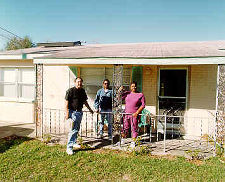 Take the example of Mrs. Sims and her family. As a single mother with three children, Mrs. Sims provides a stable family environment, maintains two jobs and is currently attending medical radiologist school.
Take the example of Mrs. Sims and her family. As a single mother with three children, Mrs. Sims provides a stable family environment, maintains two jobs and is currently attending medical radiologist school.
According to Mrs. Sims, the ICS solar system that was installed on her residence has become one of her favorite appliances. It works quite well. She doesn't have to do anything with it. It’s just there, silently creating hot water from a free energy source.
The monthly savings accrued from the solar system provide her with additional income that can be used for her family’s unavoidable expenses.
Mrs. Sims states: "I also feel like I'm doing my part in preserving natural resources as well as helping save energy and the environment. But most of all, I really appreciate the savings and extra hot water that I have enjoyed since the solar system has been installed."
Monitoring results (Sims)
| Category | Pre Solar | Post Solar |
| Installed System | ICS | |
| Installed System Cost | $1,500 | |
| Water heating energy usage (kWh per year) | 2367 | 846 |
| Water heating costs per year ($.08 per kWh) | $189 | $68 |
| Water Usage (Gals per day) | 59 | 44 |
| Solar Fraction | N/A | 0.64 |
| NEAT Saving-to-Investment Ratio | N/A | 1.03 |
Ahmadi
Mrs. Ahmadi received her solar system through the Metro-Dade Community Action Agency in 1996 and has been quite satisfied with it since. "What took you so long in providing me a solar system?" she wonders. "I've had neighbors ask about the collector on the roof and after I've told them of how great the system was, they also want one."
 The system consists of a flat-plate pumped solar collector retrofitted to a 50-gallon water heater. Sensors at the collector and pump tell an electronic controller when there is sufficient solar energy available to heat the water. At that time, the pump comes on and circulates the water from the tank through the solar collector where it is heated.
The system consists of a flat-plate pumped solar collector retrofitted to a 50-gallon water heater. Sensors at the collector and pump tell an electronic controller when there is sufficient solar energy available to heat the water. At that time, the pump comes on and circulates the water from the tank through the solar collector where it is heated.
Behind Mrs. Ahmadi and her two children in the photo above is the water heater. Above the tank is the solar system pump and piping going up to the solar collector.
"Since my solar system has an on/off switch that turns the electricity to the water heater off, during sunny days, we always keep the switch off. This way, all the hot water that I use is made by the sun. This really cuts my utility bill. I'm getting free hot water," she adds.
Monitoring results (Ahmadi)
| Category | Pre Solar | Post Solar |
| Installed System | Active Pumped | |
| Installed System Cost | $1,550 | |
| Water heating energy usage (kWh per year) | 2902 | 679 |
| Water heating costs per year ($.08 per kWh) | $232 | $54 |
| Water Usage (Gals per day) | 78 | 79 |
| Solar Fraction | N/A | 0.77 |
| NEAT Saving-to-Investment Ratio | N/A | 1.4 |
The SWAP program indicated that substantial results in energy savings could be accrued from the use of low-cost solar water heating systems. The savings-to-investment ratio met WAP requirements. Low-income clients claimed that the savings from the solar system were immediately obvious.
This program stands as an example of what solar thermal systems can accomplish.
For further information regarding this program, contact the Solar Master listed below.
